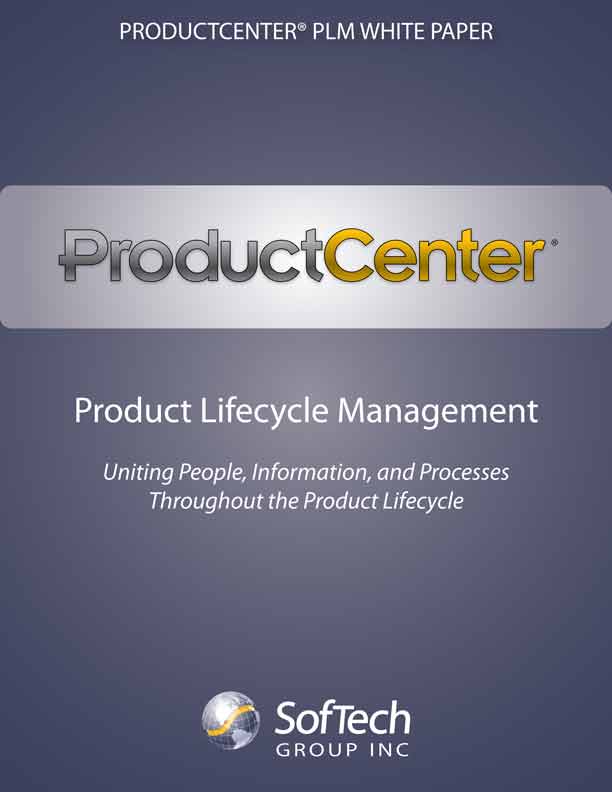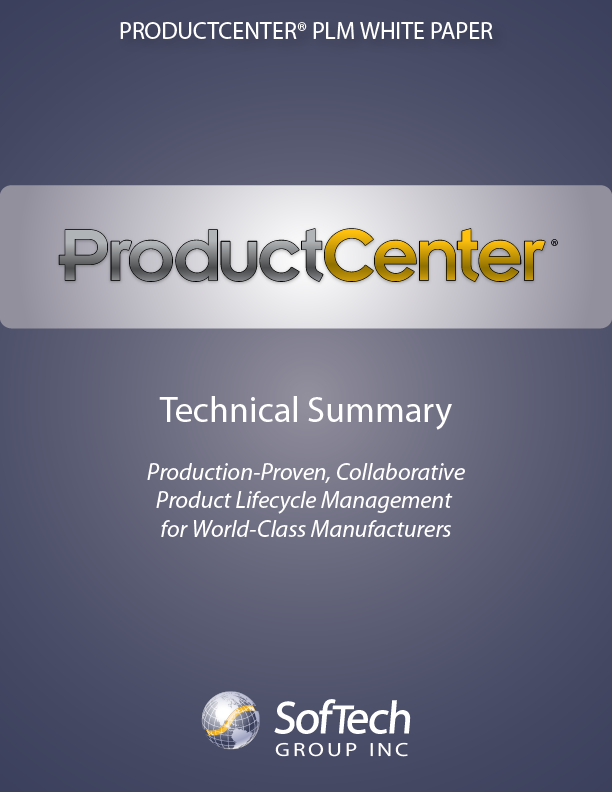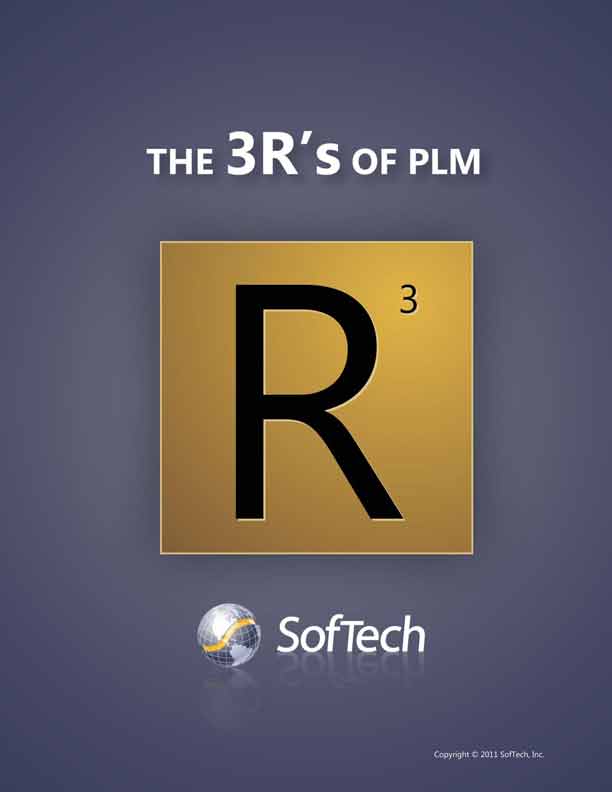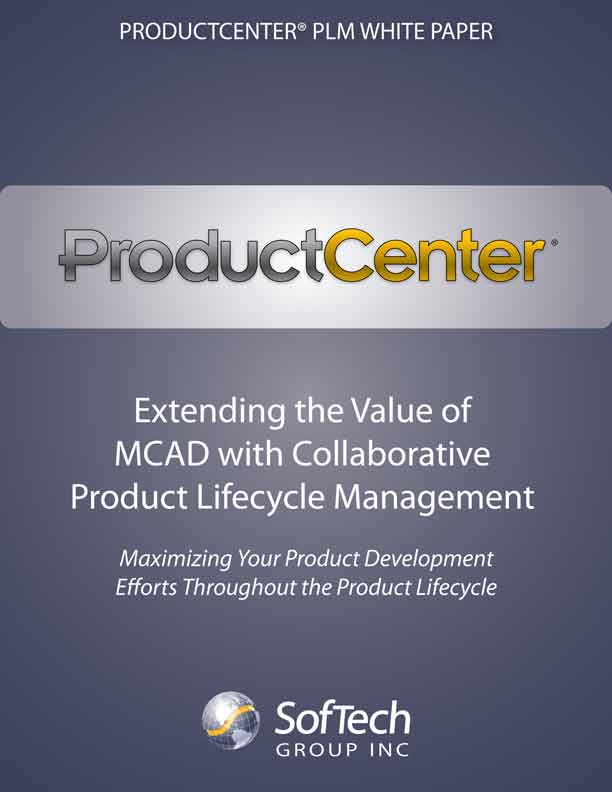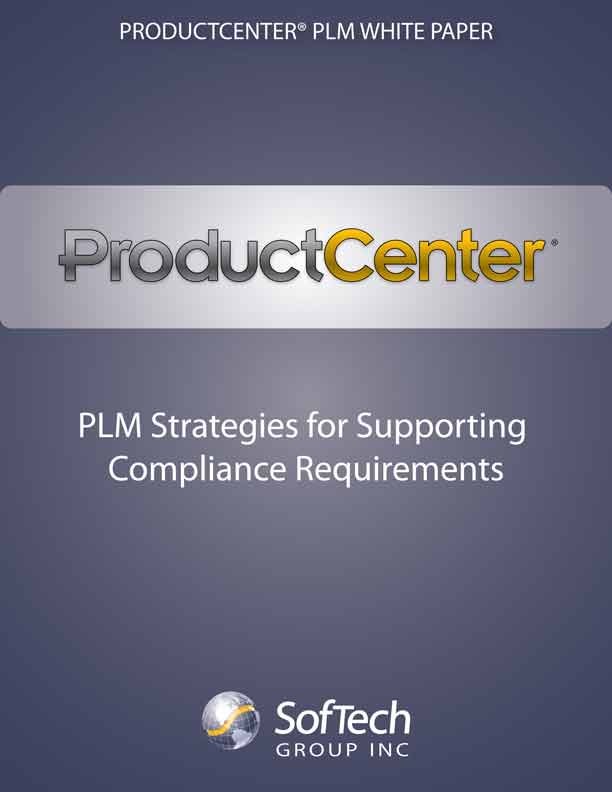Product Lifecycle Management (PLM) – White Papers
SofTech Group’s ProductCenter PLM white papers and technical summaries are useful documents for companies exploring PLM solutions or expanding their PLM implementations.
Product Lifecycle Management
Companies are adopting PLM solutions to meet a variety of challenges. They are finding that PLM helps them deal with daunting growth, global operations, and highly competitive market demands. Check out this PLM White Paper to learn what to look for in a PLM solution to avoid common pitfalls and lock in a successful PLM implementation that meets your needs.
Initially, the focus of product data management was solely on design and engineering. Eventually, the need for secure data management and control during the entire product lifecycle expanded the requirements for systems used to manage product data and processes. As companies have had to change to thrive in today’s unsettling global economy, these systems have had to as well.
Market uncertainties necessitate the ability to react quickly. Globalization and acquisitions are commonplace. Companies are outsourcing more and more, straining to communicate effectively internally, as well as with supply chain partners and customers. Development teams are stretched to their limits, faced with increasing demands for new, more complex products faster. And as always, heightened regulatory requirements drive the need for data accuracy and mistake- proof process management.
ProductCenter® PLM Technical Summary
This paper discusses implementing and integrating ProductCenter PLM with your existing legacy data and applications in a distributed environment. It overviews ProductCenter PLM data modeling and other advanced capabilities, such as version/revision control, workflow, and Bill of Materials management, as well as the adaptation of ProductCenter PLM to suit your unique requirements.
Implemented at over 150 major corporations among a user base of over 50,000, ProductCenter is exemplified for its usability, low cost of ownership, and ability to scale efficiently from small initial installations to enterprise-wide, globally dispersed systems. With ProductCenter, you’ll improve your competitive advantage with benefits that include reduced costs, shortened development cycles, higher quality products, and improved customer responsiveness. Because the software installs readily and works within the applications that your users already know, your users will be up and running with PLM quickly so you’ll see these payoffs sooner.
Many SofTech Group customers experience savings of millions of dollars annually as a result of the increased efficiencies gained with ProductCenter. Reductions in product development lifecycles of 60% or more are very common.
The 3R’s of PLM
SofTech Group’s latest white paper is geared towards those decision makers in all types of product development companies that are looking to improve business practices, global competitiveness and the bottom line.
In today’s competitive global market, companies are implementing PLM to streamline processes, which positively impacts productivity, quality and time to market. Within this white paper SofTech Group identifies three essential elements of justifying a PLM initiative, the 3R’s:
- Recognize the Need
- Retain your Intellectual Property
- Realize the Return on Investment
Automating Part Number Generation
In this white paper, SofTech Group provides insight into the Part Number Generation process and the benefits of managing this information in a Product Lifecycle Management (PLM) system.
By managing part numbers in a Product Lifecycle Management system such as SofTech Group’s ProductCenter PLM solution, you create a competitive advantage in your product development process and downstream applications by providing early visibility to part number specific information such as material, cost, vendors, physical properties and contractual requirements. ProductCenter as the central source of your company’s Bill of Information, as defined by your intellectual property and business processes, not only improves productivity but also accelerates and reduces the cost of delivering products to market.
The goal is to be able to drive measurable benefits from every aspect of your technology investments. The following are among the many benefits of incorporating a part number generation process into your comprehensive PLM strategy:
- Ensures best practices and corporate standards
- Promotes part number and design re-use
- Changing vendor information is easy
- Global, 7×24 product information availability
- Shorten Change Management processes
- Eliminates bottlenecks in the number assignment process
- Assures that duplicate part numbers are not assigned for different parts
The Comprehensive Bill of Information
As a follow up to The Top 10 Business Reasons for Implementing PLM, SofTech Group’s White Paper focuses on the Bill of Information (BOI). Many companies that employ a Product Lifecycle Management (PLM) system are only managing a limited data set of the entire product portfolio. By using a PLM system to manage the BOI, companies are able to capture the entire data set required for design, testing, manufacture, delivery, sale, and support of a product.
Companies that adopt a Bill of Information (BOI) approach with their Product Lifecycle Management (PLM) implementations will achieve the biggest gains. The BOI enables the real-time management and reporting from the entire collection of information at any point along a product’s lifecycle – from concept through retirement.
SofTech Group, Inc.’s white paper, The Comprehensive Bill of Information, provides insight into the fundamental concepts that make up a BOI, which serves as the “blueprint” that describes your finished product. To fully define your company’s intellectual property it is essential to capture, document and retain the BOI.
Going Beyond MCAD With Product Lifecycle Management
Advanced mechanical CAD solutions permit you to develop more and more complex products. The upside is that you can satisfy market demands for diverse variations and options in less time. The downside is that you require increasingly advanced configuration systems to handle the complexity. Especially useful for companies operating in a mixed CAD environment, explore this PLM White Paper to learn how a PLM solution will help you gain quick control of this highly complex data to maximize your competitiveness.
Companies that design, produce, and deliver products are working at Internet speed to maximize their competitive advantages. One of the most effective differentiators leading product makers have today is in the way they use their product information and in improving product development processes to reduce development cycle times and cost.
Product information encompasses every idea, innovation, and process step you employ, from the earliest stages of product development and through the manufacturing of your products, and beyond. It needs to be managed, monitored and continually refined in order for you to meet the demand for better products and at a faster rate of introduction. Product Lifecycle Management (PLM) solutions offer capabilities to fulfill this advantage.
PLM Strategies for Supporting Compliance Requirements
As a product developer and manufacturer, you know the complexities of introducing new products to the market. Not only are you faced with the faster time to market challenge to stay competitive, but you have the compounded task of adhering to the ever-increasing strict regulations and compliance requirements that can be complex and are continually evolving. Some may even say that compliance is one of the biggest challenges facing businesses today.
Failure to meet these regulations can result in lengthy product delays, production shutdown or even worse yet, product recalls — with devastating revenue consequences.
At the heart of compliancy, regardless of your industry, is the precise management of product data. Complete, accurate, and meticulously controlled drawings, documents and procedures are required for pre-market approval, manufacturing, and shipment of product. Missing or inaccurate data, anywhere along this path, is cause for non-compliance. Because of this, it is absolutely crucial for a company to mistake-proof management of product data and related processes — before, during, and after product release.

